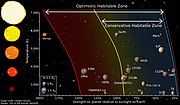 | In astronomy and astrobiology, the habitable zone (HZ), or more precisely the circumstellar habitable zone (CHZ), is the range of orbits around a star... 134 KB (13,621 words) - 17:05, 13 April 2024 |
 | A Habitable Zone for Complex Life (HZCL) is a range of distances from a star suitable for complex aerobic life. Different types of limitations preventing... 52 KB (5,804 words) - 12:33, 30 April 2024 |
 | Exoplanet (redirect from Habitability of exoplanets) zone. In several cases, multiple planets have been observed around a star. About 1 in 5 Sun-like stars have an "Earth-sized" planet in the habitable zone... 146 KB (15,828 words) - 18:56, 20 April 2024 |
 | K2-18b (category Super-Earths in the habitable zone) 6 times the radius of Earth, with a 33-day orbit within the star's habitable zone. This means it receives about a similar amount of starlight as the Earth... 40 KB (4,632 words) - 15:29, 2 May 2024 |




